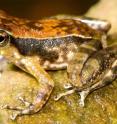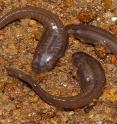Indian dancing frog's secretive tadpoles unearthed from sand beds
A new tadpole that burrows through sand has been unearthed from the streambeds in the Western Ghats of India, according to a study published March 30, 2016 in the open-access journal PLOS ONE by Gayani Senevirathne from the University of Peradeniya and colleagues. The group of scientists from University of Delhi, University of Peradeniya and Gettysburg College discovered and documented the interesting tadpole of the Indian Dancing frog family, Micrixalidae. These tadpoles were discovered from deep recesses of streambeds, where they live in total darkness until they fully develop into froglets. The identity of the tadpoles as Micrixalus herrei is genetically confirmed. These tadpoles are endowed with muscular eel-like bodies and skin-covered eyes, which facilitate burrowing through gravel beds. They lack teeth but have well-serrated jaw sheaths, which may help prevent large sand grains from entering the mouth while feeding and moving through sand. The tadpole gut contains small sand grains together with decaying organic matter, which acts as a nutrient source.
The Indian Dancing frogs typically wave their legs as a territorial and sexual display while sitting on boulders in streams. Though these displays are well known, the tadpoles of these frogs were completely unknown. This was, in fact, the only family of frogs and toads for which the tadpoles remained a mystery. Prof. SD Biju from University of Delhi says, "We provide the first confirmed report of the tadpoles of Indian Dancing frog family. These tadpoles probably remained unnoticed all these years because of their fossorial nature, which in itself is a rare occurrence in the amphibian world."
They examined the external morphology of the tadpoles and scrutinized their bones using a double staining procedure, which revealed the presence of ribs in very early stages of tadpoles. Prof. Madhava Meegaskumbura from University of Peradeniya states, "only four families of frogs are reported to have ribs, but we show that at least some of Micrixalidae also have ribs, even as tadpoles; this adaptation may provide for greater muscle attachment, helping them wriggle through sand." Also, whitish globular sacs storing calcium carbonate, known as "lime sacs," are present even in juvenile frogs of Micrixalus, which is uncommon in other frogs.
Very little is known about the habitat requirements of these tadpoles. Observations made so far show that the tadpoles inhabit sandy banks under canopy-covered streams. The new finding reiterates the uniqueness of amphibians of the Western Ghats biodiversity hotspot, providing a platform for future studies on this amphibian family, while also delivering useful information for conservation of these ancient and endemic frogs.
Major highlights: Fossorial tadpoles: they inhabit interstitial spaces within sand and gravel beds of forest streams, starting from very early to late tadpole stages Tadpoles ingest sand: their gut contents consist of sand and sediments ingested along with organic material Eel-like body: extensive tail musculature aids in underground movements Presence of ribs: these provide protection for internal organs and facilitate underground movement. This report is for the fifth family, among the 55 amphibian families known worldwide. Presence of Lime sacs/ endolymphatic sacs: act as a source of calcium carbonate for tadpoles and juveniles Specialized mouthparts with serrated jaw sheaths: act as a filter to prevent large sand particles from entering the mouth Skin-covered eyes: To provide protection from abrasion
Source: PLOS
Articles on the same topic
- Rapid transformation turns clinging tadpoles into digging adult frogsWed, 30 Mar 2016, 20:25:29 UTC
Other sources
- Rapid transformation turns clinging tadpoles into digging adult frogsfrom Science DailyThu, 31 Mar 2016, 1:50:48 UTC
- Indian dancing frog's secretive tadpoles unearthed from sand bedsfrom Science DailyThu, 31 Mar 2016, 1:50:47 UTC
- 'Dancing' tadpoles discovered in Indiafrom BBC News: Science & NatureWed, 30 Mar 2016, 20:21:07 UTC
- Rapid transformation turns clinging tadpoles into digging adult frogsfrom PhysorgWed, 30 Mar 2016, 18:20:55 UTC
- Indian dancing frog's secretive tadpoles unearthed from sand bedsfrom PhysorgWed, 30 Mar 2016, 18:20:53 UTC

